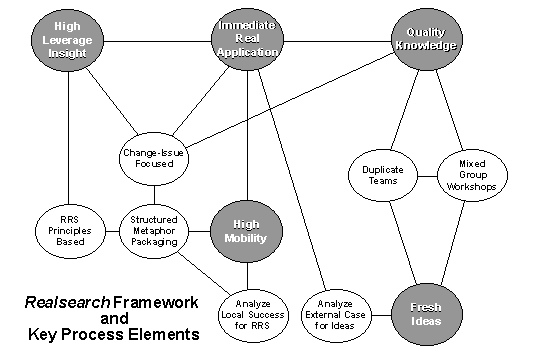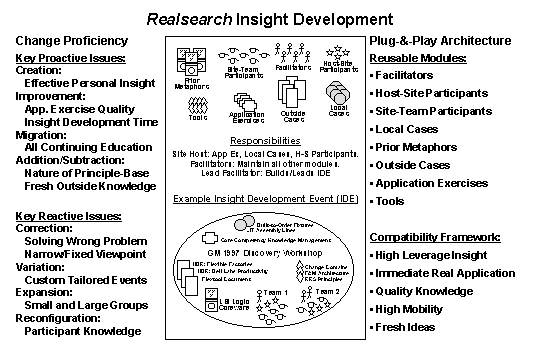 Paradigm
Shift
Paradigm
ShiftInternational
Realsearch
 Paradigm
Shift Paradigm
ShiftInternational |
Realsearch |
|
Features: Home | Library |
Corp Info |
|
(Section from paper presented at March 1998 IEEE Aerospace Conference) |
3. Framework and ProcessWe borrow and adapt the concept of activity maps from Michael Porter [10] to give a pictorial representation to the Realsearch process. Realsearch as we currently practice it has five themes (shaded bubbles in Figure 1) which constitute its strategic framework, and seven process elements (white bubbles) which support these themes. Framework themes are the main concepts that collectively distinguish this Realsearch approach from some other methodology for learning and insight development. They are the what of Realsearch. This thematic framework should remain relatively stable over time, though some evolution is expected. Key process elements are the actual primary activities or functions that define the themes in their execution, and represent how the themes are achieved. The connecting lines show strong support among the units, and strengthen consistency and coherency to the extent that there are multiple connections. |
 |
Key Process ElementsRealsearch is an issue-focused, principle-based process. In Figure 1 process elements are clustered into three groups: tools, tasks, and team makeup. Change-Issue Focused—Realsearch focuses on developing the questions before embracing answers; defining the problem before accepting solutions. Change proficient business practice has been the focus for the first application of the Realsearch process; as a consequence the activity has employed a methodology for defining problems in terms of their change-proficiency requirements [11]. The key concept here is that the item to be analyzed or designed must first be profiled as a set of issues to be resolved. The Appendix contains a short-listed version of the change proficiency issues identified during the analysis of an assembly process at General Motors. For example: At Rockwell Avionics, where we were exploring the design of a program realization process, we came eventually to understand that the primary issues were not at the operational and organizational levels, but rather with the pending crises of knowledge-worker shortages faced by all technology intense businesses. When the problem is viewed from this angle the nature of a good solution is completely different. In the Realsearch workshop consensus is sought (but never demanded) on the problem definition and not on subsequent solution designs. The emphasis on a common problem definition is important so that all solution design activity focuses on a common set of requirements. RRS Principles Based—The ten RRS (Reusable, Reconfigurable, Scalable) design principles are specifically focused on building adaptable systems (see bottom half of iconic model in the Appendix). In general, however, any set of comprehensive design principles would provide the necessary fundamental concepts for open interpretation. No two people are likely to employ fundamental knowledge to precisely the same ends. Principle-based design invites collaborative learning as each participant goes away with a deeper but very personal understanding. Principles are tools rather than recipes. The design principles provide enough structure for both the analysis and the application exercise work to channel the workshop activity toward its objective; but not enough structure to allow comfortable passive participation. Finding evidence of the principles in a practice being analyzed and employing them in the design of a new practice is thought provoking work. Basing the participant activity on fundamental principles rather than on recipe steps creates an environment in which people must actively think and struggle with new concepts. The primary objective of the Realsearch 1997 Discovery Workshop Series was in fact aimed at testing and refining this set of principles. The insights we hoped to generate would be based on these principles. The new knowledge the workshop series intended to create was the refinement and applicability of these principles in different business environments. For instance, our second workshop at General Motors analyzed two production practices that had the most blatant examples of RRS principles employed - which resulted in some major terminology refinement. These highly evident examples helped us re-articulate the principles in more communicable terms. Structured Metaphor Packaging—Realsearch employs the concept of metaphor as its principal tool for communicating insightful knowledge. The local metaphor model in the Appendix is an example of the structured packaging used in the 1997 Discovery Workshop Series. In this instance we are trying to communicate a business practice as responding well to a set of defined change issues because its design is based on RRS principles - which encompass both a framework/module architecture and the designation of persons responsible for maintenance and evolution - and facilitates the plug-and-play construction and reconfiguration of systems (business practices). A local metaphor model is not expected to communicate an insight into a specific practice all by itself. It is intended rather as a map of the knowledge pattern people will learn when studying the business practice, and as a map to be overlaid on other practices subsequently analyzed or designed. Analyze External Case for Ideas—The initial task activity undertaken in each our 1997 Discovery Workshops was the review of three or four written articles. In general, the activity here is intended to introduce new thoughts relevant to the subsequent analysis and application exercises. Though there may be other ways to accomplish this same end, written articles have some distinct advantages: they can be sent out in advance, they can carry the weight of expert authorship, and people can be assigned to present their salient points and lead a group discussion about them. We sent them in a pre-reading package to all participants, and selected one "experienced" participant to lead a group discussion at the beginning of the workshop. Discussion leaders were sent a guideline on how to conduct an interactive discussion and how to open it with a personal review of what they discerned as relevant. With three articles to be reviewed, three participants got drafted into the leadership rank: learning is accelerated by teaching. Generally the articles were chosen for the indirect but basic light they could shed on the upcoming application exercise. Thus, when we intended to explore the design of a program realization process at the Rockwell Avionics workshop we didn't choose articles that dealt directly with that subject; but rather one that dealt with corporate-culture work styles and another that dealt with controls appropriate for an empowered organizational structure. Both introduced very new view points to the participants, both provided ideas that influenced the analysis and application work, and both were praised as valued knowledge assets by the participants. Had we chosen instead articles that presented case descriptions of designs by others we would have encouraged a polarized reaction: if we favored what we read we would tend to stop thinking and construct our best design from pieces found in others, if we disliked what we read we'd waste time justifying our rejection. Analyze Local Success for RRS—The second task activity in our workshops is to analyze something done well by the workshop host - where well in our case meant in a highly adaptable fashion. The intent is to show that a practice which is familiar and respected owes its value to a design based on the very principles we are trying to develop an appreciation for. In general such practices may have been consciously designed for adaptability but have rarely been designed with fundamental principles in mind. Exposing the presence of the principles is the first tangible understanding for first-time participants, and moves implicit knowledge into the explicit category for those familiar with the practice being analyzed. At this point it becomes easier to suggest that these principles can be employed consciously in a purposeful design of another practice - they are not foreign concepts after all. The analyzed practice becomes a local metaphor in this light - one that can be pointed to for precedence when suggesting that another practice would benefit from the application of one or more of the RRS principles. Importantly for the Realsearch process, this sets the stage for the subsequent application exercise. The first of the 1997 workshops was held at LSI Logic, where we analyzed a product design system called Coreware, which allows LSI engineers to design a large portion of new semiconductor chips by stitching together pre-tested and reusable circuit modules and sub-modules from a library. We also analyzed their order fulfillment system which assembles a custom-selected team from a pre-qualified pool of sub-contractors for each order LSI gets. Both analyses were rich in RRS principles - and both provided good metaphors for attacking the application exercise: large program management as seen in plant construction projects. It turns out that a successful semiconductor company today is as much in the plant construction business as it is in the semiconductor manufacturing business. Looking at plant construction projects as a corporate core competency, and borrowing ideas from both the Coreware system and the sub-contractor management system changes the whole perspective on plant construction projects. Mixed Group Workshops—Good Realsearch results require a conscious attention to team makeup. Composing a genuinely-valuable closed corporate Realsearch workshop is difficult at best, and the smartest people in the most successful companies are the worst: they think they're open minded. Bringing outside participants into a corporate workshop adds considerably to the view points and the experience base that is brought to bear. Better yet is an open membership Realsearch team that is involved in a defined-objective, multi-workshop series. Corporate culture and corporate political reality are insidiously strong influences of what is acceptable to consider. When outsiders are included as respected participants the knowledge obtained from analysis and applied in exercises is considerably broadened. All participants must be genuinely interested in the pursuit of the Realsearch objectives, and in a position to employ the knowledge for immediate value - else the group suffers from tangential agendas. Participants should be screened for this interest. Participant experience should also be mixed when possible. This allows some to take leadership roles, which helps them develop their understanding of the knowledge being explored; and sends a message of confidence to first-time participants that the confusion will clear eventually. This mixture of experience levels benefits both new and old-hands at the process because it keeps the questions honest - and questions without answers don't go away. Duplicate Teams—Break-out groups in workshops are not a new concept. The conflict: Keep them small so everyone can and must participate; but don't have too many or there won't be enough time for full-group brief-outs. We balance this conflict by seeking a total participation of 10-20 people at any one workshop. For three-day workshops we find that breaking the full group in half for break-outs works well; though we will subdivide these two groups when total participation hits the high end of the range. Duplicate teams means that both break-out groups work on the same break-out objective. This is important in the Realsearch process as we are seeking to develop/refine a specific body of knowledge (RRS principles in our initial workshop series) by attempting to apply it. Working with new and incompletely understood concepts leads to a certain confusion as well as to different interpretations. Both conditions foster a broader exploration and questioning. Having two teams work toward the same objective has never yet produced duplicate results - and usually produces complimentary results. Other important reasons for duplicating the activity: sometimes one group will get totally lost and make no progress, sometimes one person will dominate a group and take it someplace strange, and sometimes group chemistry follows a different agenda. Most importantly, we are trying to develop a familiarity with the knowledge being explored at the depth of insight - in each participant. Insight comes from personal hands-on struggle, not from listening to someone else debrief another group's conclusions. Everyone must explore the same ground. |
 |
| View
Next Section: Testing the Approach
(Section from paper presented at March 1998 IEEE Aerospace Conference) |
|
Features: Home | Library |
Corp Info Send email to |